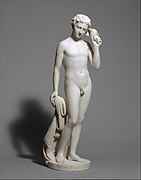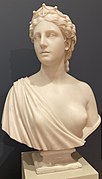Hiram Powers


Hiram Powers (July 29, 1805 – June 27, 1873) was an American neoclassical sculptor. He was one of the first 19th-century American artists to gain an international reputation, largely based on his famous marble sculpture The Greek Slave.
Early life and studies
Powers was born to a farmer on July 29, 1805 in Woodstock, Vermont.[1][2] When he was 14 years old, his family moved to Ohio, about six miles from Cincinnati, where Powers attended school for about a year[1] while staying with his father's brother, a lawyer. He began working after the death of his parents, first superintending a reading-room in connection with the chief hotel of the town, then working as a clerk in a general store.[3][4] At age 17, Powers became an assistant to Luman Watson, Cincinnati's early wooden clockmaker, who owned a clock and organ factory. Using his skill in modeling figures, Powers mastered the construction of the instruments and became the first mechanic in the factory.[1]
In 1826, he began to frequent the studio of Frederick Eckstein, and at once conceived a strong passion for the art of sculpture. His proficiency in modeling secured him the situation of general assistant and artist of the Western Museum, kept by a Louisiana naturalist of French extraction named Joseph Dorfeuille.
Career as a sculptor
Powers drew attention and local commissions in Washington, D.C. with his modeled portrait of Andrew Jackson.[2] In 1837 he moved to Italy and settled on the Via Fornace in Florence, where he had access to good supplies of marble and to traditions of stone-cutting and bronze casting. He remained in Florence till his death, though he did travel to Britain during this time. During his time in Italy, he developed a friendship with Horatio Greenough.[2] He developed a thriving business in portraiture and "fancy" parlor busts, but he also devoted his time to creating life-size, full-figure ideal subjects, many of which were also isolated as a bust. In 1839 his statue of Eve won the admiration of the leading European neoclassical sculptor, Bertel Thorvaldsen.[citation needed]

In 1843 Powers produced his most celebrated statue,
Powers' most discerning and important private client was Prince Anatole Demidoff, who owned marble full-figure versions of both the Greek Slave and the Fisher Boy and also commissioned from Powers a portrait bust of his wife, the niece of Napoleon and the Grand Duchess of Tuscany. The statues and busts Powers carved for Demidoff were exceptional in the quality and purity of the marble employed.[7]
Powers became a teacher at the Florence Accademia. One of his sons was the sculptor Preston Powers.
Hiram Powers died on June 27, 1873, and is buried, as were three of his children, at the Cimitero Protestante di Porta a' Pinti, Florence (English Cemetery, Florence).
Spiritual descendants of Hiram Powers in Europe included the notorious Futurist designer 'Thayaht,' pseudonym of Ernesto Michahelles and his brother, the notorious neo-metaphysical artist RAM, pseudonym of Ruggero Alfredo Michahelles who was awarded the "Prix Paul Guillaume" in Paris in 1937.
Collections
In 2007 the
Collections holding works by Hiram Powers include the Addison Gallery of American Art (Andover, Massachusetts), the
Gallery
-
President Andrew Jackson, modeled in 1835
-
Proserpine, 1844
-
Benjamin Franklin, 1844–60
-
America, 1854
-
Fisher Boy, 1857
-
Hope, ca. 1866
-
The Last of the Tribes, 1876–77
References
- ^ a b c Malloy, Judy Powers. "Hiram Powers (1805-1873): Vermont-born Irish American Sculptor, who Lived and Worked in Florence, Italy".
- ^ a b c d e f g "Hiram Powers". Encyclopædia Britannica. Encyclopædia Britannica. July 7, 2013.
- ^ Lynne D. Ambrosini and Rebecca A. G. Reynolds (2007). Hiram Powers: Genius in Marble. Cincinnati: Taft Museum of Art.
- ^ "Hiram Powers". Smithsonian American Art Museum. Retrieved February 5, 2019.
- ^ White, Edmund. "FRANCES TROLLOPE PORTAL". FLORIN WEBSITE.
- ^ "Book of Members, 1780–2010: Chapter P" (PDF). American Academy of Arts and Sciences. Retrieved September 23, 2016.
- ^ "Theresa Leininger-Miller reviews Hiram Powers: Genius in Marble". NCAW | Volume 17, Issue 2 | Autumn 2018. August 12, 2007. Retrieved February 5, 2019.
- ^ "2006-2008 Exhibitions". Taft Museum of Art. Retrieved February 26, 2015.
Further reading
- Tolles, Thayer. "Hiram Powers (1805–1873)". Heilbrunn Timeline of Art History. The Metropolitan Museum of Art. Retrieved May 17, 2016.
- David Wilson (2013). Hiram Powers' 'Demidoff' Fisher Boy, London. ISBN 978-0-9927224-0-1
- Lauren Lessing (2010). "Ties that Bind: Hiram Powers' Greek Slave and Nineteenth-century Marriage". American Art. 24 (Spring, 2010): 41–65.
- Lynne D. Ambrosini and Rebecca A. G. Reynolds (2007). Hiram Powers: Genius in Marble. Cincinnati: Taft Museum of Art.
- Russell E. Burke III (2000). Hiram Powers: The Last of the Tribes. New York: Hollis Taggart Galleries.
- Richard P. Wunder (1991). Hiram Powers: Vermont sculptor, 1805-1873. Associated University Presses. ISBN 0-87413-310-6.
- . The American Cyclopædia. 1879.
- Chisholm, Hugh, ed. (1911). . Encyclopædia Britannica. Vol. 27 (11th ed.). Cambridge University Press.
External links
- Art and the empire city: New York, 1825-1861, an exhibition catalog from The Metropolitan Museum of Art (fully available online as PDF), which contains material on Powers (see index)
- Artcyclopedia: list of sites featuring Powers' work







